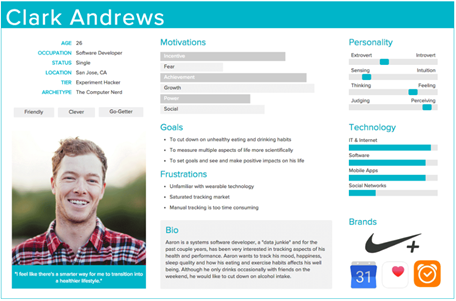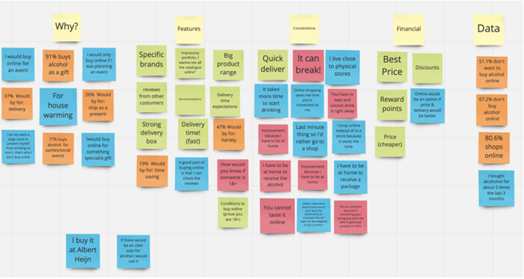We can simplify product/market fit to mean the following: the degree to which the product being sold satisfies market demand and customer needs.
These factors inevitably change over time. Therefore, it is safe to say that achieving product/market fit is an iterative process. That is, it requires tweaking and improving to perfect.
Many entrepreneurs may be confused – should they build their product around the audience they want to target, or should they stick with their product idea and test the markets that could have an interest in their product?
Depending on the nature of your product and your business, the answer may not be so straightforward. However, companies working across many industries are likely to see better results if they build their product around their target audience.
Decide your target audience
Before you start testing your product, you need to know who will be evaluating it and the criteria they will use to judge it.
Your team will need to determine the target market you want to sell to—for example, engineers with a consulting firm or a real estate agency.
Next, divide the whole market into small segments representing the potential customers you could acquire within that market.
Each of these segments will serve as a buyer persona. Buyer personas are detailed descriptions of a fictional customer who embodies what your actual customer is like. You will need to devise multiple hypotheses about these personas regarding their demographics, needs, pain points, budget, and buying behavior.
The Quantified Buyer Persona
Buyer personas are efficient if they do an excellent job at profiling a potential customer.
Each of your personas may have different backgrounds, personalities, and interests beyond the market they have in common.
Combining these characteristics will shape the best marketing and sales messages that will likely resonate with them and get them to become paying customers.
Listing several adjectives and being vague about your target customers' pain points and buying behaviors is a great disservice to your product and to your team's efforts to find a product/market fit.
Instead, make it a point to create quantified buyer personas through extensive market research and data collection from any previous or existing customers or volunteers who fit in this demographic. This hard data can stem from your business analytics, industry numbers, focus groups, surveys, and one-on-one interviews.

(Source: Medium)
Suppose you rush the process of building a product without doing your due diligence and conducting research on the right people. You run the risk of launching a product that does not provide much value to its intended audience or fails to entice them.
Much of the keys to success lie in your marketing message's ability to advertise the solution to the problem(s) your product provides and not the product itself.
The reality is if your target audience cannot see how your product can solve their pain points, you are wasting your time and resources. Keep in mind that the issue your product solves should trigger the motives behind the actions your buyer persona(s) take.
Using Job Stories to shape your hypotheses
Intercom created the Job Stories method to understand the motivations behind their potential customer's actions.
When creating hypotheses around your buyer personas, it helps to have a foundation to start from.
Job stories aim to frame your assumptions from what people want as to why they want it. Your team can fill in the following blanks from the perspective of a target customer.
“When ____________ happens, I want/need ______________ in order to ______________.”
As Intercom explains, the first blank focuses on the situation, the second on motivation, and the third on the outcome.
By taking an educated guess on what your various buyer personas would answer for each of these blank spaces, your team can devise a well-formed hypothesis.
You can then embark on customer research to test if your hypotheses were accurate or inaccurate. This is just the first step toward achieving a product/market fit.
Customer Research to understand Buyer Personas
The Job Stories method can help set the stage to identify your product's benefits that are likely to resonate with your personas.
While it is hard to invest your time in creating, launching, and advertising a product based on untested assumptions about your personas, it is unrealistic that your team will correctly address these hypotheses the first time around.
For this reason, conducting qualitative customer research to build out your buyer personas is a vital step toward future business growth. 82% of companies who exceeded their revenue goals conducted qualitative research for their customer personas.
What to look for when doing your research
When testing the assumptions you have crafted for your personas, the possibilities are endless regarding what you should be testing.
Before getting too wrapped up and confused, 6 pieces of customer insight will help your team determine what goes through your personas' mind when looking for a solution and making the decision to buy:
- Primary pain point – The main reason why buyers decide to purchase offers that are like the one you offer
- Success factors – Specific expectations buyers have that influence what they purchase. This often refers to the features that customers want from a product. This also includes how much your personas are willing to pay for the right product for them.
- Perceived barriers – Things that may prevent your persona(s) from considering your product. This can be your direct competitors, a high price point, or negative customer reviews.
- The Buyer's Journey – The process starts with your target customer looking for options to solve their pain points and ends with them making a purchasing decision.
- Decision criteria – The what and how that makes a product worth buying. This is an essential component of a customer's final purchasing decision.
- Economic factors – Are the product costs, customer per acquisition costs, ROI, and other unit economic factors profitable for your business?
Once you gather the necessary data, you will gain insight into what motivates your target customer to search for and purchase a product that delivers the solution that yours does.
With this information, you can create a marketing message that highlights the features that resonate with your target audience.
The high-value customer
The purpose of extensively researching your buyer personas is to identify your high-value customers. A high-value customer is one that is most likely to stick with your brand and pay an above-average cost to use your product. When we say above-average cost, we refer to a higher price point than your average cost.
A high-value customer is one that purchases an added feature that comes at an extra cost or purchases your most expensive subscription plan.
Conducting your research
Once you know the critical information you are looking for, you can start conducting research.
Collecting as much detailed information as possible on these personas will help your team determine how to approach their work to resonate with each group and replicate any future success.
There are various approaches your team can take to conduct extensive research on your personas.
Internal Data
Internal data refers to any data your business may already have regarding current customers. This includes sales (such as revenue and transactions), returns, and any previously collected customer demographic information.
Your product, marketing, and sales teams can use the internal data you have to create hypotheses around your target audience and the new product you want to test for product/market fit.
Affinity Mapping
Affinity mapping is a process that helps product, marketing, and sales teams brainstorm ideas and hypotheses around their customer personas.
Each participant can express their opinions verbally or on paper. Before the exercise concludes, these assumptions should be organized to identify the problem, possible solutions, and other vital factors.

(Source: Medium)
Polly Kay, Senior Marketing Manager at English Blinds, explains the role employees at her organization play in creating buyer personas.
"[While ] we undertake formal market research using a third party company…by polling our workers and people we know with products and fabrics, we ask questions like 'What sort of person do you think would buy this?' 'What type of home does this fit into?' 'What does this object say about its owner?'
At times we put swatches of fabric under people's noses and ask, 'What do you think of this?'. If the type of people that say 'it's nice' all fit a demographic or persona, we have a lead."
Affinity mapping helps produce persona skeletons with a story centered around their demographics, pain points, and possible points of contact with your brand.
However, your team will need to corroborate these ideas with data from other sources to build a reliable base before testing your product with these individuals.
Analytics
The bulk of the hard data you collect on your buyer personas is likely to come from your company or industry analytics.
Information such as conversion rates, overall sales revenue, bounce rate, search engine traffic, page traffic, and mobile traffic and conversion rates should help paint a premature picture of your buyer persona's interest in your product.
Customer Research Surveys
Customer research surveys are just one type of survey your product, marketing, and sales teams can use to understand your brand's customer sentiment.
Surveys give you insight into your potential customers' heads and help you build your buyer personas on their thoughts.
Michael Hammelburger, CEO of Cost Reduction Consultants, had this to say about using surveys, "It pays to do field research to identify the opportunities that we can tap as well as threats that should be managed effectively.
Research surveys keep [our] business on top of trends that other competitors are currently adopting."
For companies like Cost Reduction Consultants that are looking for gaps in their industry, research surveys are a useful tool to implement a competitive edge.
One-on-One Interviews
One-on-one interviews are part of your team's qualitative market research.
When conducted with at least 5 prospective customers, each persona will help verify your buyer personas' initial assumptions. This technique serves as the perfect opportunity to ask potential customers questions that collaborate and challenge the hypotheses your team previously created about them.
Interviews also provide the perfect setting to establish that your target audience needs your product. This need should be compelling enough for users to want to pay for its solution.
Listen to your potential customer's words and learn how to read between the lines. Many individuals may be too polite to tell you the whole truth about why they would not buy your product.
Focus Groups
Focus groups aim to draw from participants' beliefs, attitudes, experiences, and reactions that other methods, like surveys and one-on-one interviews, cannot.
Often, 6-10 participants recruited based on the buyer persona they represent provide feedback about your product, service, marketing message, or overall brand.
Buyer Personas are ever-evolving
As industry trends and customer needs change, the information that comprises your buyer personas should too.
With this in mind, make sure the customer personas your business bases your product build, and marketing and sales tactics on are consistently up to date to achieve more profitable results.




